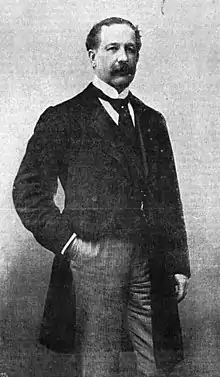William O'Shea | |
|---|---|
 O'Shea c. 1880 | |
| Member of Parliament for Galway Borough | |
| In office 1886–1886 | |
| Preceded by | T. P. O'Connor |
| Succeeded by | John Pinkerton |
| Member of Parliament for Clare | |
| In office 1880–1885 | |
| Preceded by | James Patrick Mahon Lord Francis Conyngham |
| Succeeded by | Constituency abolished |
| Personal details | |
| Born | 1840 Dublin, Ireland, UK |
| Died | 22 April 1905 (aged 65) |
| Political party | Independent Nationalist |
| Spouse | |
| Military service | |
| Allegiance | |
| Branch/service | British Army |
| Rank | Captain |
| Unit | 18th Royal Hussars |
Captain William Henry O'Shea (1840 – 22 April 1905) was an Irish soldier and Member of Parliament. He is best known for being the ex-husband of Katharine O'Shea, the long-time mistress of the Irish nationalist leader Charles Stewart Parnell.
Life
Born in Dublin, O'Shea was a captain in the 18th Hussars of the British Army.
Around 1880, his wife, Essex born Katharine O'Shea, entered into a relationship with the Irish nationalist leader Charles Stewart Parnell, with whom she had three children. O'Shea, who was already separated from his wife, knew of the relationship.
In 1882 when the Liberal government was secretly negotiating with Parnell for the terms of his release from Kilmainham Gaol where he was being held on suspicion of "treasonable practices", the President of the Board of Trade, Joseph Chamberlain, chose O'Shea as its intermediary, unaware of Parnell's affair with Mrs O'Shea or of the fact that the newly born first child of their liaison was dying.[1] O’Shea spent 6 hours negotiating with Parnell in the prison, extracting the surprising concession that Parnell would tacitly support the Government after his release. It has been suggested that O’Shea won this concession, which reflected well on him, by threatening Parnell with public exposure of his affair with Mrs O’Shea.[2]
In 1886, following insinuations of the Parnell affair and O'Shea's complicity in it appearing in the Pall Mall Gazette, O'Shea abstained from voting on the First Irish Home Rule bill and resigned his parliamentary seat the following day.[3] However, he only filed for divorce on 24 December 1889 after his wife's aunt, from whom he was expecting a large inheritance, died earlier that year leaving her estate in trust for his wife (thus allegedly violating the terms of O'Shea's marriage contract).[4][5] However, that will was overturned upon appeal, and the aunt's legacy was shared among Katharine O'Shea's siblings.
After the divorce the two surviving children of Parnell and Katharine O'Shea were given into Captain O'Shea's custody.
O'Shea was MP for Clare from 1880 to 1885 and Galway Borough for a short period in 1886. Although supported by Parnell, he was never a member of the Irish Parliamentary Party.
References
- ↑ Marsh 1994, p. 153.
- ↑ Bew 2011, pp. 92–94.
- ↑ Bew 2011, pp. 138–139.
- ↑ Marsh 1994, pp. 322–323.
- ↑ Bew 2011, pp. 165–168.
- Bew, Paul (2011). Enigma - A New Life of Charles Stewart Parnell. Gill & Macmillan. ISBN 9780717147441.
- Dungan, Myles (2009). "The Captain and the Fenians: William Henry O'Shea and The IRB". History Ireland. 17 (5): 34–37. JSTOR 40588420.
- Jordan, Jane (Autumn 2011). "The Captain and the King: William O'Shea, Parnell and Late Victorian Ireland, by Myles Dungan". Victorian Studies. Indiana University Press. 54 (1): 133–134. doi:10.2979/victorianstudies.54.1.133. JSTOR 10.2979/victorianstudies.54.1.133. S2CID 141551085.
- MacGuinness, Kevin (2009). "Myles Dungan and the Fenians". History Ireland. 17 (6): 14. JSTOR 40588443.
- Marsh, Peter T (1994). Joseph Chamberlain - Entrepreneur in Politics. New Haven and London: Yale University Press. ISBN 0300058012.
- Quinn, John F. (2015). "Jilted—Parnell and the American Heiress". History Ireland. Wordwell. 23 (1): 26–28. JSTOR 43234635.
External links
- Hansard 1803–2005: contributions in Parliament by William O'Shea
- Leigh Rayment's Historical List of MPs